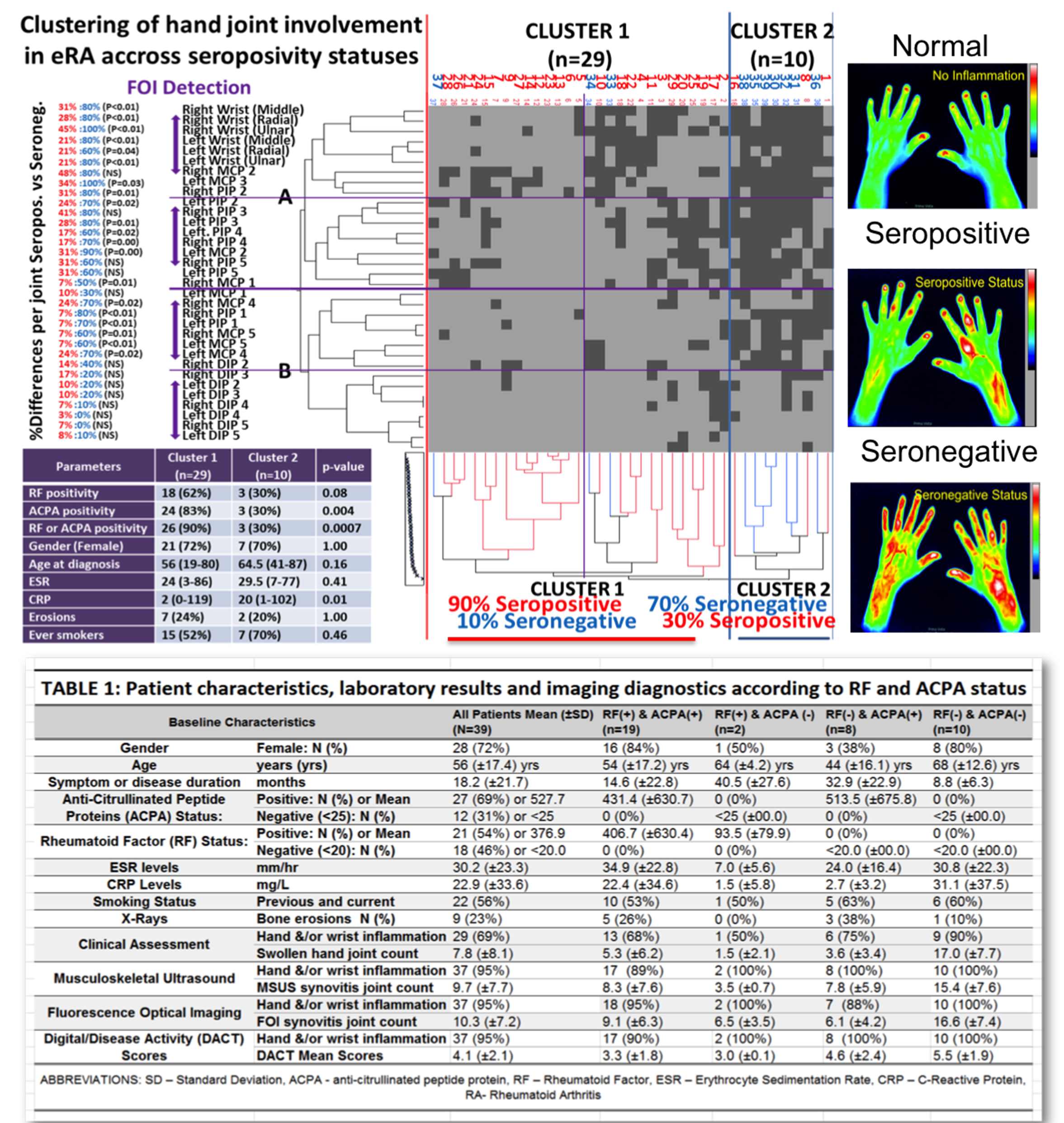Session Information
Date: Sunday, November 13, 2016
Title: Imaging of Rheumatic Diseases - Poster I: Ultrasound and Emerging Technologies
Session Type: ACR Poster Session A
Session Time: 9:00AM-11:00AM
Background/Purpose: Detection of abnormal Rheumatoid Arthritis (RA) related autoantibodies, Rheumatoid Factor (RF) and Anti- Citrullinated Peptide Antibody (ACPA), along with musculoskeletal ultrasound (MSUS) plays a critical role in early RA (eRA) diagnosis. Fluorescence optical imaging (FOI) is an emerging modality that detects subclinical hand joint inflammation1, and may therefore prove valuable in early RA assessment. Here, we analyzed the FOI results of eRA patients to determine whether patterns of hand joint inflammation were able to distinguish seropositive from seronegative eRA.
Methods: Inflammation on FOI is defined by altered microcirculation (capillary leakage/perfusion), which is seen as abnormal optical signal intensities during visual inspection of a 360-second series of hand and wrist joint images (34 joints per patient). Unsupervised ascending hierarchical clustering was used to identify clusters of patients with different patterns of joint involvement in FOI. The robustness of clustering was verified using k-means, and agreements between the 2 methods were assessed using Cohen’s kappa. Baseline clinical and biological characteristics of patients were compared between the clusters using non-parametric tests.
Results: Out of 1326 joints of 39 eRA patients (26 females; 9 with erosive RA; 54% RF+; and 69% ACPA+), 400 (30%) were considered positively inflamed by FOI. The mean (±SD) number of active joints detected by FOI was 10.3 ± 7.2 (Table). Unsupervised hierarchical clustering of joint involvement according to FOI distinguished 2 separate clusters of patients: Cluster1 (n=29) & Cluster2 (n=10). The proportion of seropositive patients was significantly higher in cluster 1 versus cluster 2 (26/29 versus 3/10, p<0.01) (Figure). The distribution of inflammation throughout the joints, except for right MCP2, PIPs 5, left MCP1 & DIPs in cluster 2 displayed distinguishable patterns (p<0.05) compared to cluster 1, which showed joint inflammation to be largely concentrated around wrists, right MCP2, bilateral MCP3, and to a lesser degree around PIPs 2-4 & left MCP2. The DIPs showed no significant differences between clusters.
Conclusion: Unsupervised hierarchical clustering revealed two distinct inflammatory patterns of joint involvement that may be distinguished in early RA, using fluorescence optical imaging. The proportions of seropositive patients were significantly different between these patterns, suggesting that FOI identifies patterns of joint involvement that are different for seropositive and seronegative RA. References: 1. Kisten Y, Györi N, af Klint E, et al. 2015 Detection of clinically manifest and silent synovitis in the hands and wrists by fluorescence optical imaging. RMD Open 2015;1: e000106. doi:10.1136/ rmdopen-2015-000106 (http://rmdopen.bmj.com/content/1/1/e000106.full.pdf+html)
To cite this abstract in AMA style:
Kisten Y, af Klint E, Rezaei H, Levitsky A, Larsson PT, Karlsson A, Györi N, van Vollenhoven RF, Arnaud L. Fluorescence Optical Imaging Reveals Distinct Patterns of Hand Joint Inflammation in Seropositive and Seronegative Early Rheumatoid Arthritis [abstract]. Arthritis Rheumatol. 2016; 68 (suppl 10). https://acrabstracts.org/abstract/fluorescence-optical-imaging-reveals-distinct-patterns-of-hand-joint-inflammation-in-seropositive-and-seronegative-early-rheumatoid-arthritis/. Accessed .« Back to 2016 ACR/ARHP Annual Meeting
ACR Meeting Abstracts - https://acrabstracts.org/abstract/fluorescence-optical-imaging-reveals-distinct-patterns-of-hand-joint-inflammation-in-seropositive-and-seronegative-early-rheumatoid-arthritis/

